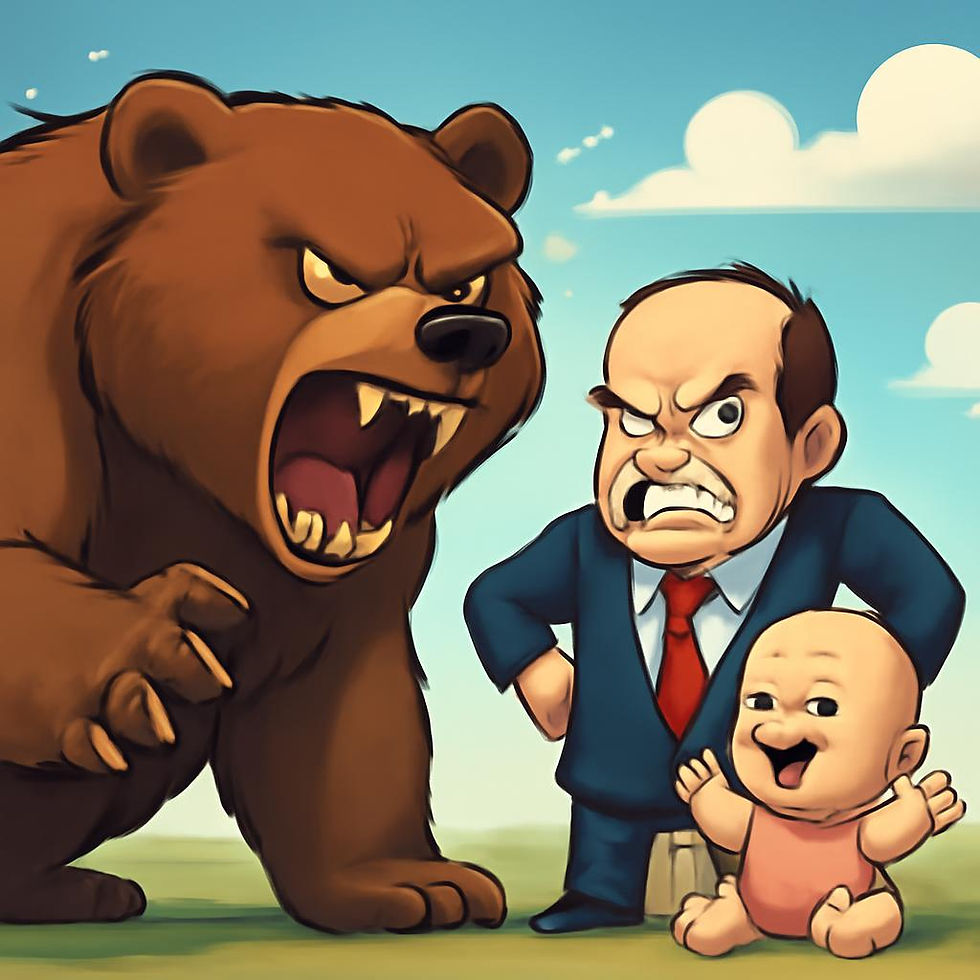A Bear, a Boss, or a Baby
- Holly McIlwain
- Jul 15
- 5 min read
Not all stress is bad.
Cortisol is released in the brain when certain stimuli are introduced (think: bear, boss, baby) and helps the body take action (think: run, work, coo). However, cortisol can be sneaky, lingering for hours after the stimuli are no longer a “threat.” We know that babies are rarely considered a threat, but work with me here—like I said, not all stress is bad.
From my nerdy research: “Cortisol secretion follows a natural 24-hour cycle. In healthy individuals, peak levels are reached about 30 minutes after waking—this early peak is known as the cortisol awakening response (CAR). Levels decline throughout the day, with the lowest levels occurring during the early sleeping phase. However, prolonged exposure to stressors can lead to overstimulation, resulting in fluctuating cortisol levels.” Source: PMC7749606
This is nothing new. Just ask anyone living with a bear, a boss, or a baby.

So, what does overstimulation and fluctuating cortisol levels actually do to the body? More nerdy research from the same peer-reviewed journal reveals: The World Health Organization (WHO) in its report “Mental health, resilience and inequalities” (Friedl, 2009) recognizes the role of low-level prolonged psychological stress in the hyperactivation of neuroendocrine, cardiovascular, and immunological systems. It highlights the link to cortisol production and how this is implicated in the development of chronic conditions such as coronary heart disease, stroke, diabetes, high blood pressure, and mental illness. Source: PMC7749606
Based on my experience with various bosses and raising babies, I can certainly say there’s something to this.
Overstimulation truly stinks. The good news? I’ve never been chased by a bear—though we did recently have a sighting in the neighborhood, so there’s always a first time!
My experiments on myself, coupled with research and client experiences, led me to create the “Predictable Patterns of Behavior.” This process identifies unique sources of unproductive stress that plague people and builds a framework to alleviate overproduction and overstimulation.
Here’s what we do when we introduce Predictable Patterns of Behavior:
Shortcut the brain
Reduce unnecessary and unproductive friction
Open up critical thinking
Sometimes I start with a psychometric assessment to better understand my clients' unique thought patterns. Other times, I can work through obstacles in a simple conversation.
Once we establish that there’s a mental load from some ‘bear, boss, or baby’ stimuli, we can determine which stimuli are productive and effective—and which aren’t.
That’s when I make it easy for them: we name the obstacle and employ predictable patterns of behavior.
Here are a few common examples from home life:
Morning Ritual: Wake up, make bed, brush teeth
Personal Item Placement: Return your car keys to the same designated location upon entering the house
Social Interactions: Call Aunt Mae on Thursday evenings on your way home from work
Physical Activity: Leg Day at the gym
Ending the Day Ritual: Read before bed
Here are a few common examples for work life:
Commuting Rituals: Drive the same route to work or school, listen to the same music or podcasts, or chat with a friend
Work Game On: Set up at the same desk or workspace, organize items in a specific way, or have a set time for breaks
And here are a few that I frequently work on with my clients for life-life:
90-Degree Breathing: Follow a pattern of body adjustments and breathing to create a pause in activity and break overstimulation
Feedback Modeling: Leverage a set formula for providing feedback to eliminate unnecessary (and often unhelpful) emotional responses
Emotional Responses: Have set responses to repeated external stimuli, such as saying “It’s unfortunate that you’ve had that experience” rather than “I’m sorry”
Based on the feedback from my clients and my own experiences, Predictable Patterns of Behavior serve us well. But why does it matter? Back to the brain: when it’s overstimulated, the stress response makes it harder to think clearly and establish effective solutions. We need these brain-energy reserves when the BIG stuff happens—like when we are suddenly confronted with a bear, a boss, or a baby. In moments like these, we need to access higher-level thinking and problem-solving.

A bear is chasing you. Do you run, freeze, or curl up in a ball? Your boss shares devastating news. Do you cry, strategize, or faint? A baby is choking. Do you scream, perform the infant Heimlich, or do CPR?
If you’re in a hyper-stimulated state, you may not be equipped to find the right solution as efficiently as necessary. By systematically reducing overstimulation and cognitive load on the brain, we become more efficient at solving problems effectively and for the long term. While Predictable Patterns of Behavior may change as circumstances evolve, the discipline shouldn’t.
Try it with one of the categories mentioned above—document your predictable pattern of behavior for your home life, work life, or the really sticky life-life stuff, and let me know how it goes. Give it 30 days to learn, 30 days to live, and 30 days to thrive.

LEADERSHIP BONUS: If you’re at the helm of an organization and need to start decreasing unhelpful mental loads and unproductive friction for your team, here are a few ways to use this skill at work to help you get UNSTUCK and efficient:
Process for Establishing Predictable Patterns of Behavior:
Establish the Purpose of the Work: What are the three key results/responsibility areas that you are uniquely keen on?
Acknowledge the Organization's Values: Clearly define observable behaviors needed to achieve these results. If you’re the boss and they’re absent, it’s time to create them. Lucky for you, you can download instructions and cards here (insert link).
Get Familiar with Individual Driving Forces: Understand what motivates individuals within the organization to act, including yourself. These are usually tied to values, behaviors, and functions.
Define Quarterly Goals, Objectives, and Metrics: Not glamorous, but critical for determining what and how you move forward, as well as which Predictable Patterns of Behavior your organization needs.
Associate Every Individual with Specific and Measurable Outcomes: Name the specific functions and groupings of tasks related to the mission and goals.
Then, brainstorm, list, and survey obstacles, points of friction, pain, and ineffective organizational (or leadership) behaviors. This is where the truth hurts, and the concept of “perspective is reality” comes into play.
It’s crucial to detach from the personal component revealed in this step and instead focus on understanding the difference between task/process conflicts and personal/relationship conflicts.
Task/Process Issues: These can be mapped, restructured, and new SOPs created. Predictable patterns of behavior for tasks and processes can provide relief for project management, time management, and resource management. A best practice here is the 3:3:3 principle: choose three behaviors to commit to for three months and assign three separate people to champion the process (one for each behavior).
Personal/Relationship Conflicts: These should map back to the organization’s values and rely on predictable patterns of behavior for communicating feedback and navigating conflict.
Need more intensive help? Perhaps it's time to reach out to NarrowSpaces Consulting to help with an organizational assessment.





Comments